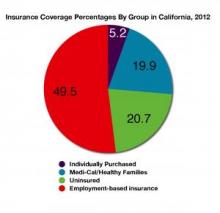Health Coverage Tilts Toward Medi-Cal

New enrollment data released by the UCLA Center for Health Policy Research indicates that Medi-Cal and other public programs are growing in influence in terms of the percentages of Californians they cover.
And while the role private sector insurance played has waned in recent years, researchers believe components of the Affordable Care Act will help make it resurgent over the next decade.
Overall, just under 20% of Californians with insurance received their coverage via Medi-Cal or the Healthy Families program in 2012, while fewer than half of the state's residents with coverage received it via commercial coverage.
In 2001, 56.4% of Californians received their insurance via employment-based coverage, and 13.7% via Medi-Cal or other public programs.
A variety of factors have contributed to the coverage shift, although the effects of the Great Recession appear to have had the largest impact. The economic downturn officially began in late 2007, when 55.6% of Californians received their coverage through commercial plans provided by their employers, and 15.3% were enrolled in Medi-Cal or Healthy Families. By 2009, the trend away from private sector coverage and toward public programs quickly accelerated.
And between 2001 and 2012, those Californians purchasing personal coverage has barely budged. And the rate of uninsured statewide has actually dropped slightly more than one percentage point overall.
Altogether, about 6.7 million Californians lacked insurance last year, with about 4.5 million going without coverage for the entire year or longer.
“In effect, public programs have stepped in as employers have stepped out," said Shana Alex Lavarreda, the Center's director of health insurance studies. “The data refutes any lingering arguments that employer-based insurance is the solution to our healthcare coverage crisis.”
Under the Affordable Care Act, the federal government is covering much of the cost for individual states to expand Medicaid eligibility. California is among 26 states that is taking the funding, and even began to increase enrollment last year through a special demonstration project.
Yet despite the growth of the Medi-Cal program, Lavarreda believes that enrollment in commercial plans will tick upward in the coming years, primarily due to enrollment through the Covered California health insurance exchange.
CalSim, a modeling project run by the UCLA Center for Health Policy Research, predicts that as many as 2 million of the state's resident will purchase insurance via the exchange over the next decade.
Lavarreda also noted that as the economic recovery continues in California, more people are obtaining jobs that offer health insurance, although the trendline remains below what it had been prior to the recession.
“Jobs that are returning to the state after the Great Recession seem to lack affordable health insurance benefits, depriving workers of a major source of coverage,” her report read.
Meanwhile, CalSim also projects that as many as 1.5 million residents will also enroll in Medi-Cal, meaning that program's pace of growth will close to match that of commercial health plans.
"These data make it clear that many Californian families are still struggling financially and will need to access low- or no-cost health coverage," said Colburn S. Wilbur, interim president and CEO of The California Wellness Foundation.
UCLA has been charting health insurance trends in California bienally in the past. But with the onset of healthcare reform, Lavarreda said the Center for Health Policy Research has now begun tracking coverage trends on an annual basis.






